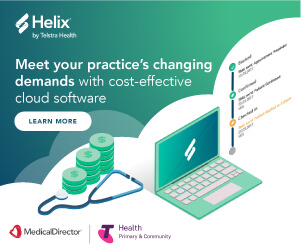Difference between ‘cloud’ and ‘on premise’ practice management software
Choosing the right practice management software doesn’t have to be difficult. In this article, we explain some of the basic differences between cloud-based software and traditional ‘on premise’ tools, to help you decide which solution works best for you.
Differences in how information is stored
This is the main difference between on-premise and cloud-based solutions. Cloud-based practice management software stores all information on the Internet ‘the cloud,’ which is then backed up by premium security data centres, like the Microsoft Azure platform.
‘On premise’ practice management software stores all your data on physical servers that are on your medical practice site, and server management either remains your responsibility or outsourced to an IT provider.
Differences in how information is accessed
When your clinical and practice management information is stored on ‘the cloud,’ it is not limited to a physical server, which means you can access it anywhere, anytime and on any device. This is particularly important if you want the flexibility to work outside the physical office, and for health professionals who want to offer remote care.
Data contained in ‘on premise’ software however, can only be accessed within the medical practice, which means you and your team need to be physically in the medical practice to use it.
Differences in how information is maintained
Maintenance and system upgrades are extremely important with “practice management software“, in order to maintain the security of patient data and keep the software running smoothly. With cloud-based systems, updates happen automatically, with very little down time for the user.
However with on premise systems, all maintenance, system upgrades, cooling equipment and power delivery tools are the responsibility of your medical practice where the servers themselves are located. This can be relatively more costly and time consuming in the long run than the simplicity and security of the cloud.
Differences in how information is integrated
Cloud-based practice management software can be easily integrated with the growing range of cloud-based health and business solutions available on the market, such as online booking apps, health information apps, wellness apps and internet-based payment and billing systems. This means your practice will be more equipped to handle the future of health, which is all about interoperability, integration and a more cohesive digital ecosystem.
Practice management software that is based on premise, won’t necessarily support this level of interoperability and integration, which is why more practices that want to future-proof their practice are turning to the cloud.
Practice Management Software checklist:
- Find an innovative solution to streamline workflow
- Choose a system that is easy to set up, understand and navigate
- Implement software that automates workflow and minimises admin burden
- Ensure your solution has the strictest data security measures
- Find a solution that integrates with wider systems like EFTPOS payment
- Implement a mobile solution for home visits, remote care and aged care
- Implement a flexible solution that allows you to work anywhere, on any device
- Ensure your solution supports the patient journey
- Find a solution that scales as your practice grows









